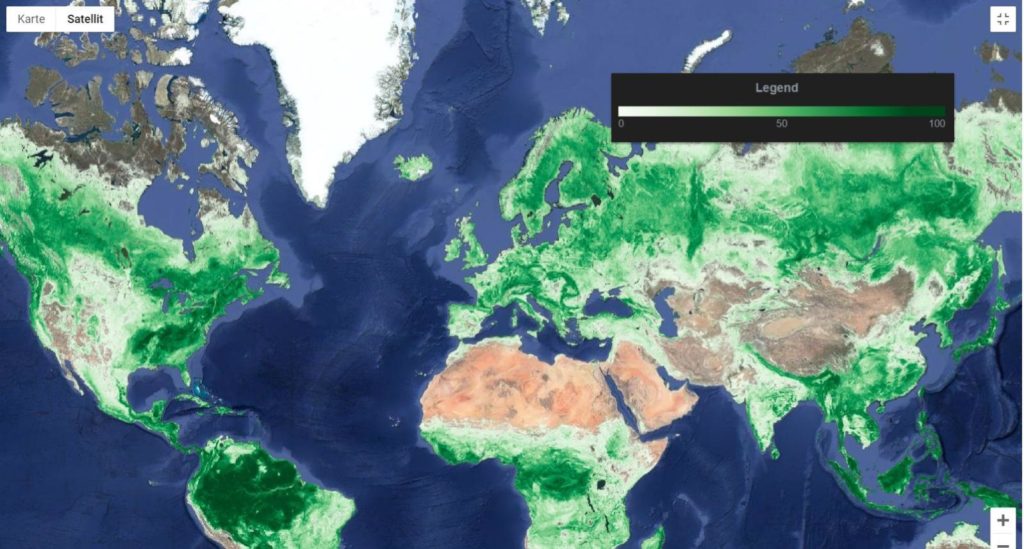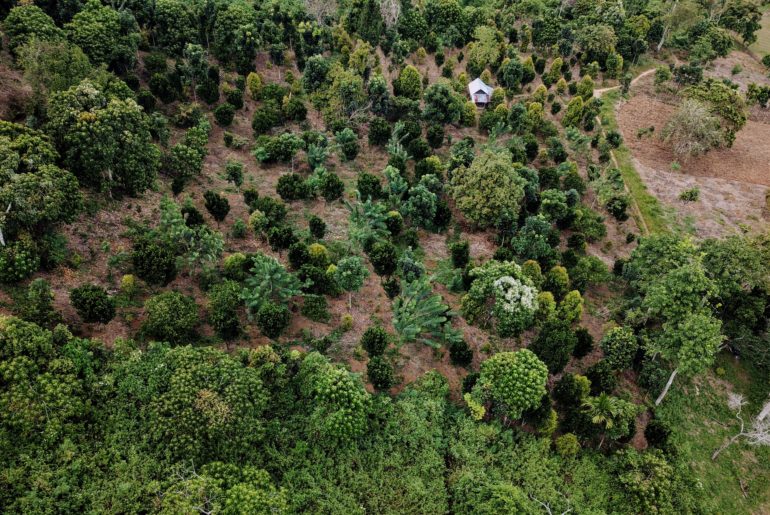Why forest restoration is the most successful carbon sequestration technology?
In this article, we discuss the potential and effectiveness of forests to capture carbon dioxide from the atmosphere. Besides cutting current emissions, forests reveal to be the “breakthrough technology” to sequester already emitted carbon on a large scale while restoring valuable habitats for animals, plants, and people.
The goals are clear. We need to bring down the carbon dioxide level in the atmosphere to keep the temperature increase below 1.5 – 2 degrees of pre-industrial times while restoring climate-relevant ecosystem functions. Without acting, climate warming is having irreversible and severe effects on ecosystems and our societies.
There are plenty of ways to contribute and positively impact the climate and environment. But where to focus resources and attention for the highest impact? Project Drawdown can be a guide by ranking various solutions and their potential emission reduction.
Focus on technology only
Despite many efficient carbon sequestration or avoidance approaches in the fields of materials, food, land use, transportation, and energy, today I still perceive a hype and focus that is calling for high-tech solutions so-called “break-through technologies” to solve the problems of climate change. For example, electric cars, synthetic fuels, direct air capture (which is described in the following infobox).
Comparison of costs for carbon capture technologies vs. forest restoration: The idea of building industrial infrastructures to extract carbon dioxide directly from the air (see image 1. direct air capturing plant) has been successfully tested. As ambitious as the idea sounds the current cost of about 600 USD per ton makes implementation very expensive. Even the best hope of Carbon Engineering might only bring the costs down to about 100 USD per ton of carbon. Even then, removing just 1% of global carbon emissions would cost around $400bn a year, and would need to be continued forever. Storing the CO2 permanently would cost extra (Guardian 2018). Besides the high costs, these man-made technological solutions are not capable of providing other ecosystem services alongside with carbon capture: restoration of ecosystems with all their values such as stabilizing ecosystem cycles, soil protection, water retention, habitat for animals and plants, recreation for people, provision timber and food. In comparison, a tree that is planted, in some cases, for below 1 USD is able to store more than a ton of carbon during its lifetime. Moreover, biodiverse forests instead of forest monocultures, have the double capacity of forest and soil carbon storage.

Technical solutions as wind and solar energy, electric mobility, and carbon capture technologies can play an important role to help to cut current emissions, but we need to be realistic and not rely on potential technological developments only. There is plenty of room for action with fewer costs and more comprehensive results. We can
- reduce our climate-damaging consumption;
- promote environmental friendly politics to protect existing forests, grasslands, savannas, wetlands, and peatlands;
- restore forest ecosystems
- …
… and we need a combination of all!
Potential of forest restoration
Several facts of the following text have been transcribed from a keynote speech by Thomas Crowther at The Bühler Networking Days 2019.
On average, an additional 10 billion gigatonnes of carbon, caused by human activities are added every year to the atmosphere. Some of it gets sequestered naturally by the land and ocean, however, a big amount accumulates in the atmosphere. Since the start of the industrial revolution, we have built up a 300 gigatonnes burden of additional carbon to the atmosphere which has led to significant global warming with negative effects on ecosystems. This burden must be reduced to keep temperatures below an acceptable level. To achieve this goal, all activities that bring down the level of CO2 in the atmosphere have to be evaluated for their effectiveness.
Contributing to carbon sequestration, what potential do forests have?
The current number of trees on earth is estimated to be about 3 trillion. According to a recent publication by Bastin et. al. (Science 2019), there is an area of 0.9 billion hectares of land available to plant an additional 500 billion trees. These trees can increase the current forest cover by more than 25%. A successful implementation will lead to an additional 205 gigatonnes of carbon stored in areas that would naturally support woodlands and forests.
This is about two-thirds of the man-made 300 gigatonnes of carbon.
Some might argue that planting trees and restoring forests sounds like a naive idea when considering the opportunity cost of potential reforestations area for agricultural and urban land use. It is important to point out that the discussed global tree restoration is calculated for mostly degraded sites without urban and agricultural use potential. In other words, the Forest Restoration Potential and its spatial distribution are calculated by subtracting the Current Forest Cover and the urban and agricultural land from the Potential Forest Cover (if no humans were present)
The following maps visualize the Forest Restoration Potential and its calculation:
Forest Restoration Potential (Image 4) = Potential Forest Cover (Image 2) (if no humans were present) – Current Forest Cover (Image 3) – Urban and agricultural land


Hansen et al., 2013. Screenshot https://www.crowtherlab.com/maps-2/

The numbers and maps show us that forest restoration and afforestation is not a naive idea. Tree planting is one of our most powerful strategies to bring down CO2 concentrations across the globe. Moreover, trees help to restore valuable habitats for plants and animals, protect soils and water while creating clouds that increase the sun reflection and have a physical cooling effect.
Which forests and land-use types are most effective for carbon sequestration?
Carbon sequestration takes place in vegetation and soil.
In tropical regions, trees grow much faster than in temperate or boreal regions and can take up CO2 faster within their biomass. Whereas in colder regions, forests grow slower, but a similar slower decomposition of the organic matters leads over time to a higher accumulation of soil carbon than in the tropics. Both approaches have to work hand in hand for fast and sustainable carbon sequestration.
In addition to the living biomass, soil carbon has an additional storage potential of 116 gigatons. The following table shows the distribution of the potential uptake of carbon in different land-use types and their sequestration efficiencies.
| Land-Use | Uptake of Carbon | Efficiency |
| Wetlands and Peatlands | 31% | On less than 10% of the world’s surface. Highest efficiency in comparison to other land use. |
| Forests | 30% | The storage of additional soil carbon is a side effect of close to nature forest restoration. |
| Grass and Shrublands | 39% | Huge areas are available. They require non-disturbing soil management like no-tilling and no overgrazing to become a carbon sink. |
The great news about storing additional soil carbon is that it does not come at the expense of any other land-use types.
Success of tree planting initiatives
What is the status and achieved success of current tree planting programs? According to Thomas Crowther (The Bühler Networking Days 2019) on average, only 30% of the trees that have been planted survive. In other words, 70% of the effort and resources are wasted. This shows that it is not enough to just plant as many trees as possible. So what can be done to significantly increase the survival rate of planted trees?
From my experience working in reforestation, we need to carefully
- analyze the site conditions like local climate, water-, and nutrient availability, soil structures, terrain;
- select tree species which are part of the potential natural vegetation and provenances which are adapted to the specific site conditions;
- source healthy planting material, either harvest it from natural forests or grow it in well-managed nurseries;
- select the right reforestation method or a combination like vegetative propagation, seedlings, seeds, natural regeneration;
- transport planting material to the planting sites without too much water stress;
- prepare the site for seeding or planting seedlings without harming the roots;
- maintain competing vegetation like fast-growing grasses;
- protect the saplings from grazing animals, hoofed game, rodents, insects, fungi, fire, droughts, floods, and logging.
All that is required is local knowledge and expertise in silviculture, recent geoinformation for planning and laying out the forest restoration activities, and constant monitoring and management. Planting trees can have a success rate of more than 80% which can be achieved with diligent planning and careful execution.
Further, successful reforestation requires secured land rights as well as free prior and informed consent of all involved stakeholders. Reforestation programs need to make sure that people understand and want reforestation. Projects, therefore, need to be socially responsible. If not, the forest will vanish quickly. The management covers not only the technical activities of reforestation but also requires close and equal collaboration with local communities. Transparent communication is at the core of successful reforestation efforts.
A tool for the reforestation community
With the aim to bring more transparency and help with visual communication of reforestation efforts, we have built up explorer.land which is a map-based communication tool that documents reforestation projects in time and space while bringing together the community of sustainable reforestation projects and responsible investors.
We imagine explorer.land to become the place and tool for pioneers who apply the most sophisticated and successful “break-through technology” of our time. A scalable and living technology that stores atmospheric carbon dioxide in biomass and soil, protects our water sources and create habitats for animals and plants while stabilizing our climate for generations to come.
Trees!




